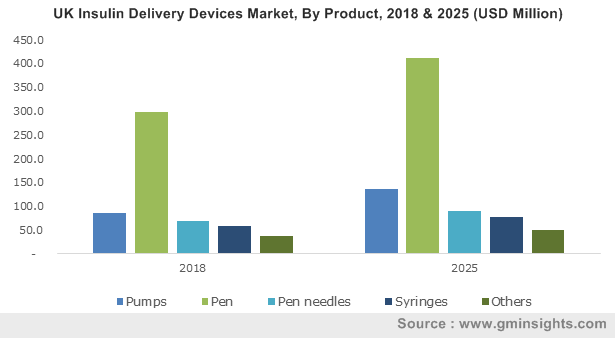Insulin delivery devices market to witness phenomenal growth prospects in the U.S, technological supremacy of the region to fuel growth
Publisher : Fractovia | Published Date : 2018-07-23Request Sample
The worldwide prevalence of diabetes has promulgated the insulin delivery devices market, in a bid to distribute effective methods to patients for inoculating the insulin used to control blood sugar levels. Touted as one of the most common noncommunicable diseases, diabetes has floundered the healthcare industry into investing huge sums for R&D aimed at diagnosing the disease and to offer realistic treatments for control, if not the cure. The insulin delivery devices market has also benefited from the edification of developed economies regarding all the aspects of managing the disease. People are able to identify the symptoms and are encouraged to opt for treatment options, including insulin devices and monitoring kits. The pervasiveness of unhealthy eating habits and the lack of physical activities among adults has raised the frequency of diabetic cases, supplementing the expansion of the insulin delivery devices industry.
U.S. Insulin Delivery Devices Market, By Product, 2013 – 2024 (USD Billion)

Boasting revenues of over USD 12 billion in 2017, the significance of the insulin delivery devices market can be determined by referring to alarming global figures on diabetes. According to a report by Statista, an estimated 8.8 percent of the overall adult population in 2017 had diabetes and this number is slated to reach around 9.9 percent by 2045. The evolution of medicine has paved the way for recognizing potential solutions to previously dreaded ailments like diabetes, and the technological advances in healthcare have empowered the industry to produce efficient modes of delivering those solutions.
Having the most enhanced healthcare system and knowledge base in the world, U.S. dominated the insulin delivery devices market with recorded earnings of USD 5 billion in 2017. The technical capabilities of the country is ably supported by the growing disposable income levels of the populace and government initiatives to spread the awareness around diabetes and its control. It is projected that approx. 30.3 million people in the U.S. have diabetes - which accounts for 9.4 percent of the entire U.S. population. As inappropriate food consumption, indifference towards physical exercise and genetic predisposition will propel the number of diabetic patients in the country, the U.S. insulin delivery devices market can be expected to flourish further owing to continuous efforts for innovating innocuous, non-invasive treatment procedures.
Speaking of different treatment methods, the insulin delivery devices market has been undergoing notable changes in terms of the preferred delivery instruments. Since the treatment of diabetes began, insulin has been mostly injected by patients subcutaneously through syringes and insulin pens. However, medical professionals are gradually sensing the need for safer, minimally invasive or even non-invasive devices to deliver insulin into the blood stream. One of the popular less-invasive devices existing in the insulin delivery devices industry is the insulin pump, which permits people to have a firmer control over diabetes along with improving the physical quality of patients struggling with the daily use of injections.
Practically, insulin pumps involve a catheter being implanted every 2-3 days through which a patient can take insulin as and when needed. The patient can set different rates of delivery at desired time of the day, experience flexibility of intake as per food or exercise and have reduced risks of any complications. Although less popular and limited to certain diabetic groups as compared to the traditional needle based delivery, insulin pumps are gaining traction in most developed nations. The rise in spending on medical services and increasing availability of insurance to cover the costs of diabetes treatment will accelerate the overall insulin delivery devices market.
A giant leap forward for the insulin delivery devices industry is the augment of a device dubbed as artificial pancreas. Studies indicate that these devices have resulted in better control of sugar levels in blood for inpatients having Type 2 diabetes as compared to manual insulin intakes. Already approved by the FDA for treating Type 1 diabetes in 2016, artificial pancreas keep the blood glucose in target zones consistently and industry experts surmise that this technology can tremendously reduce the workload of doctors and nurses in the future. The system reportedly adjusts to the rising and falling of glucose in the body and could be used to manage the glucose levels for millions of diabetics patients every year.
The so called artificial pancreas are another example of minimally invasive devices, signifying the development potential of the insulin delivery devices market. The industry landscape is clustered by leading medicine and healthcare technology companies like Sanofi, Novo Nordisk, Roche, Medtronic, Insulet Corporation and Eli Lilly. Bolstered by the focus of major players on introducing new products and expanding their territorial outreach, the insulin delivery devices market is anticipated to grow at a CAGR of more than 6.5% from 2018 to 2024.